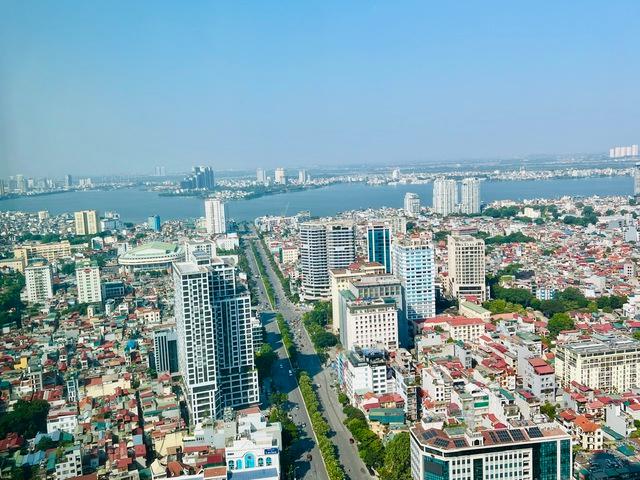In the third quarter of 2025, the Hanoi apartment market continued to record an upward trend in selling prices. Although the primary price exceeded 100 million VND/m2, the absorption rate in the market still reached 70-80%. This is the information shared by Ms. Nguyen Hoai An, Senior Director of CBRE Vietnam in Hanoi, in an interview with us.
Reporter: Madam, can you share about the development of apartment prices in Hanoi in the third quarter of 2025?
Ms. Nguyen Hoai An: The third quarter of 2025 recorded a record increase in new supply, mainly from projects with asking prices exceeding VND 120 million/m2. Projects for sale are spread across many areas, notably Tay Ho, Cau Giay and Long Bien – places with convenient infrastructure connections. Notably, high prices are also spreading to the suburbs, as more and more projects in Dan Phuong and Van Giang (Hung Yen) – areas bordering Hanoi – have starting prices from VND 60 million/m2 or more.

In terms of price developments, the upward trend continued in both the primary and secondary markets. The average primary asking price in the quarter exceeded VND90 million/m2 net, higher than the average in Ho Chi Minh City. Compared to the previous quarter, primary prices in Hanoi increased by 16%. Meanwhile, the secondary market recorded an average price of about VND58 million/m2 net (excluding VAT and maintenance fee), up 19% year-on-year. Although this growth rate is slower than in 2024, it has accelerated again compared to the first two quarters of the year.
Reporter: Can you tell us about the market trading situation in the last quarter?
Ms. Nguyen Hoai An: Sales activities in the Hanoi apartment market are bustling as many investors continue to launch new products from existing projects. Projects located near the center and with convenient traffic connections have recorded a sharp increase in asking prices, contributing to the general price level.
Notably, even areas that were once considered to have reasonable selling prices such as Dan Phuong and Van Giang (Hung Yen) have witnessed significantly higher new prices. This development is driven by the appearance of large, experienced developers, along with the completion of infrastructure and the formation of modern residential clusters, causing real estate values in the area to increase rapidly.
Although primary prices are at a high level, most of the projects launched in the quarter still achieved a positive absorption rate, averaging 70-80% of the total units launched on the market. This shows that the investment cash flow into Hanoi real estate remains stable, and the market has not shown any signs of slowing down despite increasing price pressure.
Reporter: Madam, why are housing prices increasing while market liquidity is still good?
Ms. Nguyen Hoai An: Although apartment prices, especially in the primary market, have increased to the highest level in many years, liquidity remains positive. There are a number of core reasons explaining this seemingly paradoxical phenomenon.
Firstly, most buyers at the current stage have an investment mindset. Projects for sale usually have a handover time in the next 2-3 years, which means that buyers do not need a place to live immediately but mainly see this as an investment accompanying the investor in the process of forming the project. If they really need a house to live in immediately, they often choose secondary products or completed apartments. This shows that investment demand is still the main driving force of the market.
Second, the low interest rate environment is an important supporting factor. When the cost of capital is cheap, investors tend to shift their cash flow to real estate – a channel to accumulate assets with real value and stable profitability. On the other hand, compared to other investment channels such as gold or stocks, real estate is still attractive in terms of safety and potential for price increase. For example, the domestic gold price has increased by 65% over the past year – a testament to the general upward trend of assets – and that has more or less created a psychological spillover effect on the housing market.

Third, the flexible sales policies of investors also contribute to maintaining good liquidity. Interest support packages, payment extension, or incentives for buyers to pay quickly continue to be maintained, although not as “special” as in previous periods. However, the stability and transparency of this policy makes it easier for buyers to make decisions.
Finally, the psychology of accumulating assets through real estate, especially apartments in Hanoi and the North, is becoming a clear trend. In the context of limited land funds and increasing real housing demand, apartments are considered a product for both living and for rental exploitation or to maintain asset value. This helps maintain good liquidity, despite the high price level.
The combination of the above factors shows that, despite the sharp increase in prices, confidence in real estate – especially the apartment segment – is still maintained, thanks to the combination of investment expectations, a favorable financial environment and a sustainable asset accumulation mentality.
Reporter: What is your forecast for the upcoming Hanoi apartment market?
Ms. Nguyen Hoai An: In the last months of 2025, the Hanoi apartment market is expected to continue to maintain its vibrant momentum. Notably, the product structure will be more diverse in terms of location and price, when more projects in the 50-60 million VND/m2 segment appear, contributing to expanding the choices for buyers.
In terms of selling prices, the secondary market is forecast to continue its upward trend until the end of the year, with an increase of about 20% compared to the same period last year. Although lower than the sharp increase in 2024, this is still a high increase, reflecting stable demand and investor confidence in the market. However, if secondary prices continue to increase sharply in the coming time, the risk of imbalance between real demand and buyers’ ability to pay may become a notable issue, affecting the sustainability of the market.
In that context, increasing supply, diversifying products, along with improving infrastructure and implementing reasonable policies from management agencies will play a key role in helping maintain the stability and healthy development of the Hanoi apartment market in the period of 2026-2027.
Reporter: Thank you for this conversation!
